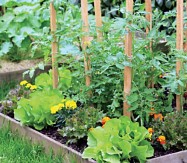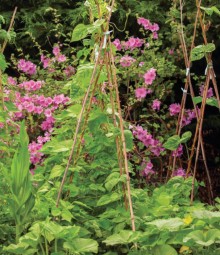GARDENING
CLOSE IN
"Intercropping" means growing two or more crops together to save space. Plants should be placed close enough so that their leaves will touch, shading the ground between them when they are fully mature. This will keep weeds down and conserve moisture, eliminating the need to mulch and weed. As the plants begin to crowd out their neighbors, harvest the early-maturing ones, leaving room for the others to develop.
• Pair lettuce with longer-season vegetables such as broccoli, peppers, or tomatoes.

ROOT FOR PAIRS
Some intercropping partners thrive if their roots occupy a different depth of soil.
• Pair shallow-rooted vegetables, such as bush beans, with deeply rooted beets to make good use of space without creating root competition.
• Plant heavy feeders such as cabbage or cucumbers with light-feeding carrots or beans to reduce the competition for soil nutrients.

GROW UP
Lay out your garden plot (see Gardenplanner.almanac.com for a free trial of our software) or set out your pots with the fence, trellis, or wall on the north side. By planting the tallest plants there, you will avoid shading the smaller ones. Vining plants, if left to sprawl, take up valuable space in a small garden, so help them to grow up.
• Cucumbers will eagerly climb a nylon net fence, from which the dangling fruit grow straighter and are easier to pick.
• Peas and pole beans will cover a wire fence or twine around a tripod of poles.
• Some heavier plants, such as cantaloupes, melons, and winter squashes, may need help in climbing, so tie their vines to the structure to get them going in the right direction. Support the fruit with slings to keep them from tearing off the vine too soon.
• Tomatoes produce more fruit and ripen earlier if kept off the ground on a trellis or in a wire cage. (continued)
Photos, from left: NCAImages/Getty Images; PamelaJoeMcFarlane/Getty Images